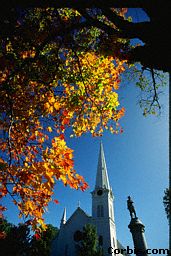Greater Boston is a fascinating combination of the old and the new. Boston proper is the hub of this busy complex, which many proper Bostonians still believe is the hub of the universe. Boston is a haven for walkers; in fact, strolling along its streets is advised to get a true sense of this most European of all American cities. Traffic is heavy. The streets (many of them narrow and one-way) run at odd angles and expressway traffic speeds. Boston wealth of historic sights makes it a must for all who are interested in America's past. John Winthrop and 800 colonists first settled in Charlestown, and moved to Boston in 1630. Arriving too late to plant, 200 colonists died during the first winter, mostly of starvation. In the spring, a ship arrived with provisions, and the new Puritan Commonwealth began to thrive and grow. Fisheries, fur trapping, lumbering, and trading with Native Americans were the foundation of Boston's commerce. The port is still viable, with 250 wharves along 30 miles of berthing space. British troops fired in an angry mob, killing six in what has since been called The Boston Massacre. In 1773, The Boston Tea Party dumped East Indian tea into the bay in a dramatic protest against restriction of colonial trade by British governors. Great Britain closed the port in retaliation. The course of history was set. In April, 1775, British General Thomas Gage decided to march on Concord to capture military supplies and overwhelm the countryside. During the night of April 18-19, Paul Revere, William Dawes, and Samuel Prescott spread the news to Lexington and Concord in a ride immortalized, somewhat inaccurately, by Henry Wadsworth Longfellow. The American Revolution had begun in earnest; The Battles of Lexington and Concord. On March 17, 1776, General Williams Howe, commander of the British forces, evacuated the city.
Mention Boston and many people will automatically think of the gentry of Beacon Hill, with their elegant homes and rigid social code. However, the Irish have long had a powerful influence in Boston's politics and personality, while a stroll down an Italian neighborhood on the North End will be like stepping back to the old country. With more than 100 universities, colleges, and trade and vocational schools in the area, Boston as a city as full of vigor and promise for the future as it is rich with the past. Harvard University, America's oldest university, was founded here in 1636. Two years later, when a minister named John Harvard died and left half his estate and his considerable personal library, it was named for him. Massachusetts Institute of Technology (MIT) also was founded here in 1861, one of the greatest science and engineering schools in the world.
Dining and shopping are generally expensive here, but downtown's sight and museums can be seen cheaply, and they offer a historical richness rivaled by few other cities. The predominately Italian North End is small and easy to travese on foot, though twisting road make it easy to get lost. Shop here for incredible pastries and baked goods. The nation's first Chinatown is a densely packed enclave where you can get authentic Chinese food, even as late as 4 a.m. Posh Back Bay is son of like Boston's second downtown. Shopping is at its trendiest and most expensive on Newbury Street; Copley Place is a solid indoor alternative. You can also hit up the John Hancock Tower and tons of hip bars and restaurants. The South End is home to many galleries; it also boasts its fair share of eateries and nightlife, much of it gay & lesbian. The Fenway Park is the country's oldest ballpark in operation. The Faneuil Hall was the first market in the city. Boston Common has been used over the centuries for public rallies and celebrations, recreation, military training, public punishment and burial, and pastureland for cows and sheep. In 1728, the first tree-lined pedestrian mall was laid out in the Common, and in the 19th century, enthusiasms for the American parks movement led to new walk ways, statues, plaques, fountain, and gates. Today, you can picnic with squirrels and pigeons, wade in the Frog Pond in summer or ice skate on it in the winter, watch old movies on a big screen for free during the Classic Film Festival, or take in some culture during the free Shakespeare performances in the Bandstand in late June.
Finding truly cheap lodging in Boston is almost always difficult, if not impossible. Planning ahead is essential in order to get a room. Before you set out the paint the town red, there are a few things to know about nightlife in Boston. Nearly every place requires 21+ photos ID to get in. Boston bars and clubs are notoriously strict about the minimum age. Closing time is 2 a.m. http://www.cityofboston.gov/calendar/calendar.asp offer complete lists of what happening in the Hub. Visit also Boston Facts & Figures and A Tale of Two Bostons.
|


